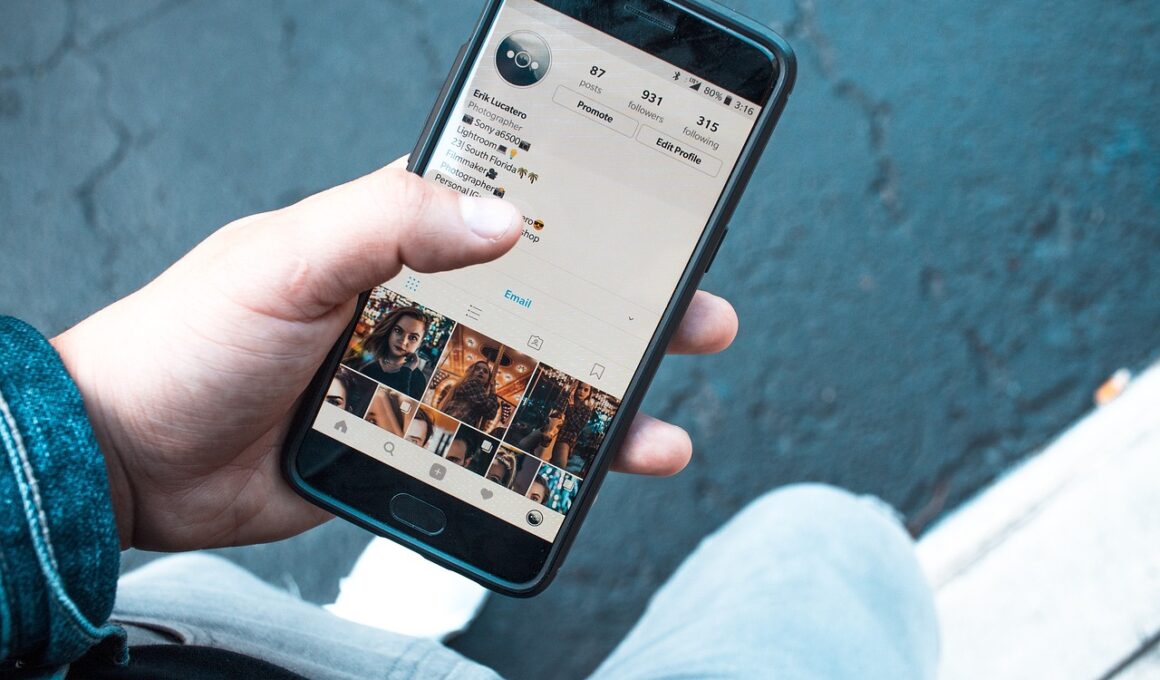Integrating User-Generated Mobile Content in Social Campaigns
User-generated content (UGC) has revolutionized the landscape of social media marketing. It empowers consumers to express themselves, share their experiences, and influence others. Integrating this content into social campaigns can significantly enhance brand visibility and engagement. One of the key benefits is fostering a sense of community among users. When brands share content created by their customers, it not only showcases real-world usage but also encourages others to participate. Additionally, UGC adds authenticity, making the brand’s message more relatable. It is crucial for marketers to curate these contributions effectively, ensuring alignment with the brand’s image and campaign objectives. Encouraging customers to generate content through challenges or contests can lead to an influx of material to choose from. Some strategies include prompting customers with specific hashtags or providing incentives for sharing quality content. By featuring authentic stories from users on social media platforms, brands can improve not only their reach but also their credibility. Ultimately, the goal is to create a two-way dialogue, wherein customer feedback drives future content creation and campaign strategies truly resonate with the target audience.
Mobile social media platforms serve as ideal forums for user-generated content, making it easier for brands to tap into this potential. With the rise of smartphones, consumers are empowered to capture and share their moments instantaneously. This immediacy creates a wealth of content that reflects genuine opinions and experiences. Leveraging mobile-optimized campaigns is essential for maximizing visibility and engagement. Brands can encourage users to share their stories through photos, videos, and reviews directly from their devices, scavenging for rich, authentic material. Another effective approach is utilizing features like stories on Instagram or Facebook, which allow brands to spotlight UGC in real-time. Additionally, implementing strong calls-to-action in marketing materials can inspire user participation and content sharing. Crucially, it’s important for brands to maintain transparency about how UGC will be used, respecting user rights while effectively promoting the brand. Engaging influencers can also facilitate this process—they often have established relationships with audiences that trust them. As a result, their endorsements, amplified by user-generated content, can significantly boost a campaign’s credibility and overall effectiveness. By incorporating UGC, brands can build more meaningful connections with their audience.
The visual nature of mobile social media makes it conducive for UGC integration. Images and videos resonate more strongly compared to text-based posts, allowing brands to deliver their messages more effectively. According to recent studies, users are more likely to share visual content, which can amplify a campaign’s reach exponentially. Therefore, brands must prioritize visually appealing UGC as part of their content strategy. Elements like product showcases, lifestyle illustrations, and consumer testimonials can be powerful components of mobile campaigns. Moreover, marketers can leverage user-created videos as micro-advertisements, exhibiting products in real-life scenarios. By repurposing this content, brands demonstrate customer satisfaction and foster organic trust. Additionally, by acknowledging and encouraging user contributions, brands exhibit appreciation for their customers. The emotional connection nurtured through this engagement can lead to increased loyalty and advocacy. Another significant aspect is ensuring that the content is sharable across various platforms. Brands can use cross-promotions to encourage sharing of UGC on multiple channels, maximizing their potential viewership. To further enhance engagement, it is essential to respond positively to user contributions, showing that their input is valued and rewarding participation.
Steps to Effectively Curate UGC
The process of curating user-generated content for social campaigns involves strategic planning and execution. First, brands must outline their campaign goals and objectives, ensuring they align with overall marketing strategies. This clarity helps in determining the type of UGC that will be most effective in meeting those goals. Next, brands should identify the right platforms to solicit contributions, whether through social media posts, specific contests, or direct engagement initiatives. Cultivating an interactive environment encourages users to share their experiences, which can provide valuable insights. It’s crucial to create clear guidelines about content submission, including quality standards and themes. This ensures that the submitted UGC resonates with the brand’s identity and campaign message consistently. Once branded UGC is collected, it’s important to monitor and evaluate the engagement it generates while measuring its impact on key performance indicators, such as reach, likes, and conversions. Lastly, celebrating and sharing outstanding user submissions not only recognizes contributors but fosters ongoing participation from the community, building a positive feedback loop that amplifies brand loyalty and encourages further engagement.
Another vital step is maintaining ongoing connections with the audience beyond the initial campaign. Following up with users who shared their content can nurture a long-term relationship. Leveraging email marketing and social media to keep audiences engaged and informed about forthcoming campaigns can aid this process. Brands should consider creating a community around their UGC. This could be achieved through exclusive groups or pages dedicated to users, encouraging ongoing dialogue and allowing customers to feel more connected to the brand. As campaigns evolve, soliciting user feedback on both UGC strategies and overall brand performance can provide insights for enhancement and innovation. Additionally, showcasing user-generated content in newsletters or blogs can demonstrate appreciation while maintaining communication lines open. These avenues provide customers the opportunity to see how their contributions positively impact brand visibility. Importantly, discussing how shared content led to changes or improvements within the company further solidifies the relationship. Building and maintaining this community around UGC fosters loyalty while also providing brands with continuous authentic content to amplify in future campaigns.
Moreover, analytics play a pivotal role in measuring the efficacy of user-generated content in social campaigns. Marketers can utilize various metrics to analyze audience engagement with UGC. Such data reveals insights into which type of content resonates best, guiding future campaign adjustments for optimal performance. Understanding the demographics of those engaging with UGC can also reveal patterns, indicating how different segments perceive the brand. A/B testing various campaigns can lend insight into the effectiveness of distinct UGC approaches and refine resource allocation. It’s essential for brands to remain adaptable, as social media trends evolve rapidly. Monitoring changes in user preferences and behavior will help brands stay ahead of the curve in their engagement strategies. Using dashboards to analyze UGC’s real-time performance can assist brands in making immediate adjustments during a campaign. This proactive approach allows for maximal engagement while minimizing wasted resources. Finally, fostering a culture of feedback within the brand can inspire innovative campaign ideas revolving around UGC that can ultimately lead to deeper connections and increased brand loyalty in the long run.
The Future of UGC in Mobile Campaigns
The landscape of user-generated content is ever-evolving, particularly with advancements in mobile technology. As augmented reality (AR) and virtual reality (VR) technologies become mainstream, UGC will likely take on new dimensions. Brands must keep pace with these developments, exploring innovative ways to incorporate interactive UGC into campaigns. For instance, users might soon create immersive experiences that allow potential customers to visualize products firsthand or share experiences in a more engaging manner. Additionally, artificial intelligence could play a role in curating and personalizing UGC, enabling brands to present the most relevant content to target audiences. Such innovations could enhance the effectiveness of mobile campaigns significantly while fostering deeper user connections. Importantly, ethical considerations surrounding user content ownership will likely gain prominence in discussions about UGC. Brands must address these aspects transparently to build trust among their audiences. As more consumers become aware of their rights, brands that prioritize ethical practices in their UGC campaigns will stand out. Ultimately, the future of user-generated mobile content in social campaigns hinges on authenticity, engagement, and technological adaptation.
In conclusion, the integration of user-generated mobile content into social media campaigns is not merely a trend; it is a foundational strategy for the future of marketing. Each element of UGC contributes to creating a more interactive and authentic brand experience. By actively engaging users, brands can benefit from a continuously evolving repository of genuine content that reflects real customer sentiments. The community aspect of UGC fosters brand loyalty and customer trust, two crucial aspects of any sustainable marketing strategy. Embracing UGC not only aids in promotional efforts but also offers valuable insights that can shape product development and service improvements. Brands that focus on the ongoing relationship with their users will find themselves not only retaining customers but also cultivating brand advocates. The importance of authenticity cannot be overstated, especially as consumers become increasingly savvy and discerning. Moving forward, brands must navigate this landscape attentively, leveraging emerging technologies while remaining committed to transparency and ethical practices. Therefore, integrating user-generated mobile content is an imperative for any brand striving to succeed in today’s competitive market. This integration paves the way for deeper connections, enhanced trust, and genuine engagement.


